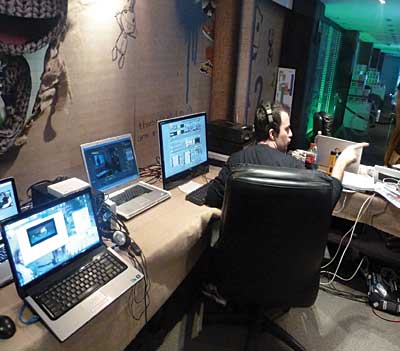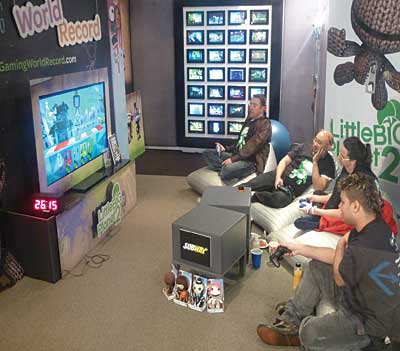Sony Sets Video Game World Records During Marathon Webcast
Live webcasting always produces significant challenges, but a live webcast for 52 hours nonstop poses some unique ones. First, having a dozen or more computers in a small control room that doubled as a staging area with lots of people coming and going produces a significant amount of heat. Early on, it was important to add fans to increase the circulation and ensure that none of the encoders or TriCasters overheated. Some of the computers were also raised slightly off the workspace to provide a flow of air underneath them.
 Another technical challenge was ensuring that all of the content could be captured and saved for archival and postproduction purposes. The archive was also critical for the Guinness World Records staff to be able to verify the length of time the gamers played the video games. The production was completely digital, so no hard copies in the way of videotapes were produced as a part of the live recording. Instead, the content was captured by the TriCasters in MPEG-2 format, and a backup was captured in AVI format using Adobe Premiere CS4. With live streaming encoders running for 52 hours straight, there was obviously no way to archive from the streaming encoders as a 52-hour file would be completely unmanageable. Therefore, it was necessary to stop and restart the archive recordings every hour or so to make the file sizes reasonable to manage and transfer from one machine to another for editing and uploading.
Another technical challenge was ensuring that all of the content could be captured and saved for archival and postproduction purposes. The archive was also critical for the Guinness World Records staff to be able to verify the length of time the gamers played the video games. The production was completely digital, so no hard copies in the way of videotapes were produced as a part of the live recording. Instead, the content was captured by the TriCasters in MPEG-2 format, and a backup was captured in AVI format using Adobe Premiere CS4. With live streaming encoders running for 52 hours straight, there was obviously no way to archive from the streaming encoders as a 52-hour file would be completely unmanageable. Therefore, it was necessary to stop and restart the archive recordings every hour or so to make the file sizes reasonable to manage and transfer from one machine to another for editing and uploading.
A third challenge was trying to come up with a way to provide 52 hours of content that would not only retain viewership but also engage and grow the audience virally during the event. This was primarily a challenge for the content producers, but it was also necessary for the technical team to provide them the widest amount of flexibility to ensure that something was always available to show in the hosted stream. To provide this flexibility, the feeds from both the PlayStation and the gamers’ cameras were run from their respective TriCasters and into the TriCaster, where the two cameras for the hosted stream were switched from as third and fourth inputs. This allowed for the hosted stream to switch to “check in” with the other two feeds, allowing the hosted stream content to be prepared and set up into segments. In addition, this allowed for ideas pertaining to what content the hosted feed should include to remain fluid and flexible to maximize the creative freedom. The importance of this freedom became evident the very first night the stream ran through the middle of the night.
In case you aren’t familiar with the game LittleBigPlanet 2, one feature is that it allows users to create new levels and minigames within the game. On the first night, as the elite gamers were cruising through levels, it appeared that they might need additional levels to challenge them. Fortunately, the team members at Media Molecule who created the game were there to help. The hosted camera was turned on them as they created game levels on-the-fly live in front of a thousand or more viewers in the middle of the night. The segment was a huge hit, generating a viral spike at a time we assumed might be the quietest during the webcast. As a result, the next day additional segments were created as tutorial segments with the game designers teaching viewers live how to create new levels for the game. With the live “tachometer” showing the current viewership, it was evident right away that these segments were successful in driving new viewership as the numbers spiked by as much as 40% at these times.
 One of the most obvious benefits of a live webcast is its ability to engage the audience in participatory behavior. With this event, the most obvious success was the Twitter feed that flowed continuously with chatter both among the viewers with each other and with the gamers themselves. One of the most popular facets of the webcast was the ability for gamers to pose questions and comments to the gamers who were able to see the comments in real time and respond to the viewers directly to the camera pointing at them. This resulted in the event generating nearly 25,000 tweets and more than 3,000 “likes” in a little more than 2 days during the event.
One of the most obvious benefits of a live webcast is its ability to engage the audience in participatory behavior. With this event, the most obvious success was the Twitter feed that flowed continuously with chatter both among the viewers with each other and with the gamers themselves. One of the most popular facets of the webcast was the ability for gamers to pose questions and comments to the gamers who were able to see the comments in real time and respond to the viewers directly to the camera pointing at them. This resulted in the event generating nearly 25,000 tweets and more than 3,000 “likes” in a little more than 2 days during the event.
After months of preparation, several days of setup and testing, and 52 hours of streaming, was producing a live streaming webcast the right choice for success? In this case, the expression “the proof is in the pudding” is particularly appropriate—which is to say, “To fully test something, you need to experience it for yourself.” Obviously, Sony did something right. LittleBigPlanet 2 debuted atop the worldwide sales charts leading sales in North America and the U.K. and Europe in both multiplatform and PlayStation categories. The streams themselves delivered almost 2.9 million total sessions and almost 5 terabytes of data transferred over the 52 hours. Game over.
This case study originally ran in the August/September 2011 issue of Streaming Media magazine.
Related Articles
In the Streaming Media West opening day keynote, PlayStation offered tips on becoming a media company.
08 Nov 2011
Companies and Suppliers Mentioned